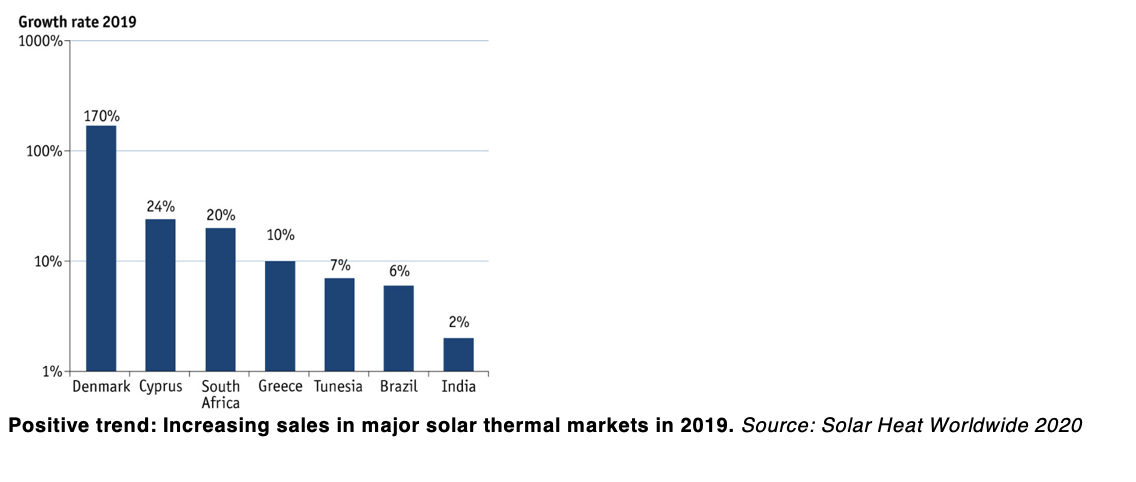Solar thermal for district heating is on the rise worldwide. In Denmark, this market grew by about 170% in 2019 and other countries like China and Germany, primarily due to its improved cost-competitiveness. Market growth was also driven by the rising demand for industrial and agricultural applications. While residential water heating systems, the largest market sector, were under pressure in China and Central Europe from competing technologies, residential sales increased significantly in South Africa, Greece, Cyprus, and Brazil.
These are some findings from this year’s report, Solar Heat Worldwide 2020, published by the International Energy Agency’s Solar Heating and Cooling Technology Collaboration Programme (IEA SHC). The full report is available for free on the IEA SHC website.
“It is true that solar thermal is going through challenging times, but it is important to note that this is mainly due to declines in the Chinese market. But despite this trend, solar thermal is experiencing steady growth in two key sectors – district heating and industrial processes. Plus, solar heating and cooling technologies will always have a positive impact on climate protection,” states Daniel Mugnier, Chairman of the IEA SHC Programme. SHC systems in operation globally in 2019 totaled 479 GWth (684 million square meters) and saved 41.9 million tons of oil equivalent and avoided 135.1 million tons of CO2 emissions.
Shifting Global Markets
The market for new installations once again varied by country, with shrinking volumes in large markets like China, the USA, Germany, and Australia. Driven by the decline in new collector installations of about 8% in China, the worldwide market shrank approximately 6% in 2019 compared to 2018. On the flip side, Denmark reported another banner year with a 170% growth rate, followed by Cyprus, South Africa, Greece, Tunisia, Brazil, and India.
Small-scale Solar Thermal Heating Systems
Systems that provide hot water and heating in residential and public buildings, as well as hotels and hospitals and public buildings, represent around 60% of the newly added systems. A key point to note is that significant market growth occurred mostly only in those countries with market sales dominated by small scale systems (in particular thermosiphon systems). The report shows that national social housing programs linked with the installation of solar water heating systems have a very successful impact on market development.
Large-scale Solar Systems
Megawatt installations are on the rise. At least 74 new large-scale (>350 kWth) systems were commissioned in 2019 to provide heat for district networks and large buildings. About 400 large solar thermal systems (>350 kWth; 500 m²) connected to district heating networks and in residential buildings were in operation at the end of 2019 with a total capacity equal to 1.62 GWth or 2.3 million m2.
As of early 2020, 800 solar process heat plants with a collector area of 1 million m2 were installed worldwide.
Two new applications to note in this sector are solar heated greenhouses, which include systems ranging from 126 m² collector area to just over 14,000 m² and solar heated gas pressure control systems, which use solar to heat natural gas at gas pressure regulation stations during pipeline transportation, an interesting niche application being used in several systems in Germany.
Heat and Electricity from the Same Roof
For the second time, Solar Heat Worldwide carried out a market survey among Photovoltaic-Thermal (PVT) collector manufacturers. A PVT system is unique in that it combines the production of both types of solar energy – solar heat and solar electricity, thus reaching higher yields per area. This application is particularly valuable when the available roof area is limited, but a climate-neutral energy supply is wanted.
The PVT market is gaining momentum in several European countries and represents 58% of the global installations, of which 41% are in France. Asia, excluding China, follows with 24% of the installations and then China with 11%. Total PVT capacity by the end of 2019 reached 606 MWth and the PV power was 208 MWpeak worldwide, an increase of 9% compared to the end of 2018.
Solar Heat Worldwide
First published in 2005, Solar Heat Worldwide 2020 provides market data on installed capacities, costs, and share of applications from 68 countries. The 86-page report includes a special focus on thermosiphon systems and overviews of different commercial applications. Solar Heat Worldwide has a solid reputation as a reference source for solar heating and cooling data among international organizations, including REN21 and International Renewable Energy Agency (IRENA). The study was again the main contributor to the solar heating and cooling chapters of REN21’s Renewable 2020 Global Status Report (GSR), one of the key policy adviser reports on renewables.
About IEA SHC
The International Energy Agency, Solar Heating and Cooling Technology Collaboration Programme (IEA SHC) is an international research and information program on solar heating and cooling technologies. Over 150 experts from 19 countries, the European Commission, and six international organizations conduct collaborative research on a wide range of topics from solar envelope solutions to future storage tank concepts and the integration of large-scale solar fields in district heating and cooling networks. SHC is one of the oldest Technology Collaboration Programmes of the IEA, founded in 1977 and one of ten addressing a specific renewable energy source.
Contact information
IEA SHC Communications: communications@iea-shc.org, http://www.iea-shc.org
Free download – Solar Heat Worldwide 2020 & Key Messages
https://www.iea-shc.org/solar-heat-worldwide-2020


